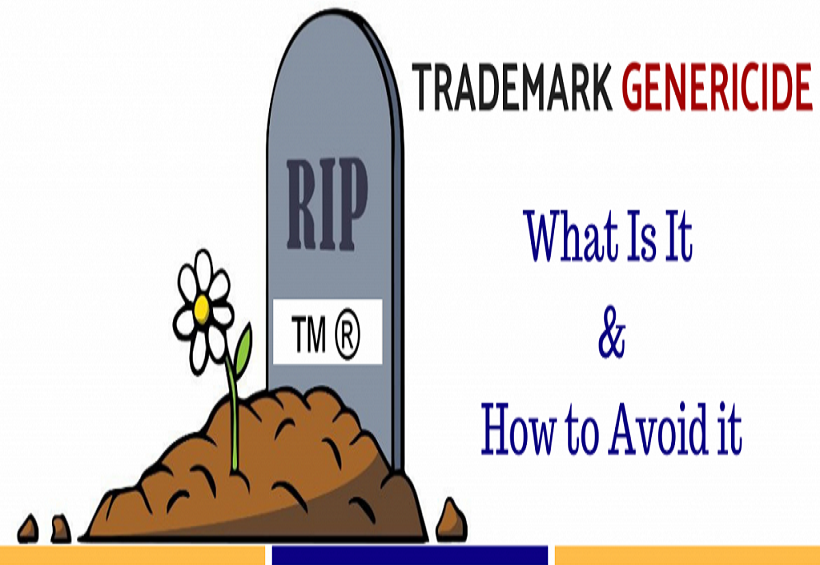INTRODUCTION
Turning a product/trademark into a household name might be the end game for every trademark owner but this can quickly turn into a nightmare when consumers perceive the trademark as the name of the product itself. The trademark will lose its distinctiveness due to its popularity and rival businesses like vultures could then quickly descend on the trademark! Once these rival businesses convince the courts that the trademark has lost its distinctiveness, they could then become entitled to the use of the trademark thereby making the trademark the victim of GENERICIDE.1
Twitter in a bid to protect its trademark stated in its Initial Public Offer filing that “There is a risk that the word ‘Tweet’ could become so commonly used that it becomes synonymous with any short comment posted publicly on the internet, and if this happens, we could lose protection of this trademark.” 2 Google also published rules of proper usage of its entire trademark following several suits to make google a generic term.3 This article seeks to examine the meaning of a generic trademark and how to protect a trade mark from genericide.
WHAT IS A TRADEMARK?
In order to comprehend the meaning of a generic trade mark, and how some marks fall into the public domain (through a process known as “genericide”) or become generic, one first has to understand what the basic functions of a trademark are.
The Black’s Law Dictionary4, defines a trademark as “A distinctive mark of authenticity, through which the products of particular manufacturers or the vendible commodities of particular merchants may be distinguished from those of others”.
Under section 67 of the Trademarks Act5 (the Act) “ Trademark means, except in relation to a certification trademark, a mark used or proposed to be used in relation to goods for the purpose of indicating, or so as to indicate, a connection in the course of the course of trade between the goods and some person having the right either as proprietor or as registered user to use the mark whether with or without any indication of the identity of the person, and means, in relation to a certification trade mark, a mark registered or deemed to have been registered under Section 43 of this Act”.
In Ferodo Limited & Anor v. Ibeto Industries Limited6, the Court per Mustapher, JSC defined a trademark as “A distinctive picture which would indicate to a purchaser of an article bearing it, the means of getting the same article in future, by getting an article with the same mark on it”.
From the above, it is clear that the primary function of a trademark is to distinguish the manufacturer or originator of the goods or services as being separate from the services and goods produced by other businesses which may be of a similar kind. The trademark sets the specific product apart from similar ones in the market and helps to create a niche for it.
In confirming this, Section 9 (2) of the Act provides that the major requirement for a mark to be registrable is distinctiveness and defined ‘distinctive’ as “….adapted, in relation to the goods in respect of which a trademark is registered or proposed to be registered, to distinguish goods with which the proprietor of the trademark is or may be connected in the course of trade from goods in the case of which no such connection subsists, either generally or, where the trademark is registered or proposed to be registered subject to limitations, in relation to use within the extent of the registration.”
Thus, a mark that is no longer capable of being distinguished in the manner above cannot serve the primary function of a trademark and, hence, cannot be registered or continue to be registered as a trademark as captured in section 13 of the Act. Examples of such marks as provided in sections 11, 12 and 13 of the Act include marks not being, according to its ordinary signification, a geographical name or a surname, deceptive or scandalous marks, names of chemical substances, identical and resembling trademarks which resemble such a trademark as to be likely to deceive or cause confusion.
However, the main focus of this work are marks, which are initially distinctive and qualify for registration, but for one reason or the other become incapable of being distinguished or which, over time, lose their quality of distinctiveness. Once a trademark has lost this distinctive quality or function, it will no longer be qualified to act as a trademark. Accordingly, a trademark that is not capable of distinguishing, within the meaning of Section 9(2) of the Act, is liable to be removed from the Register of Trademarks.7
Consequently, a trademark owner must, at all costs, strive to save his/her valuable trademark from genericide and falling into the public domain.
WHAT IS A GENERIC TRADE MARK?
A generic trademark, also known as a proprietary eponym or genericized trademark, is a term which, owing to its popularity, has become the generic name for a particular class of goods and services, to the dislike of the trademark owner. It is an unintended outcome for a trademark owner whose brand has grown and become well known in the market place. We shall broach some of the more common and household examples that many of us can relate with in the course of this article.
The term or trademark used to describe a particular good or service may start out as a normal trademark, however, the term may become so popular or dominant that the general public, against the wishes of the trademark’s holder, now refer to all classes of the product or service by the trademark of that particular good or service. When this occurs, the trademark is said to be genericized. While the long term objective of the trademark holder is to become a household name, there is a thin line between a household trademark and a generic name, which if crossed, could lead to unpleasant consequences. It then becomes incumbent on the trade
mark holder to deliberately exercise caution in the quest to make the mark well known so as not to lose its distinctiveness.
Over the years certain trademarks such as Cellophane, Laundromat, Aspirin, Escalator and Thermos have become generic marks. In other words, these once distinctive trademarks have become descriptive over time or they now generally define a class of goods such that they no longer serve to identify the goods of a particular manufacturer.
HOW DOES A TRADEMARK SUFFER GENERICITY?
A trademark does not just lose its status and fall into genericity by effluxion of time. There are certain conditions which must be satisfied before a trademark loses its distinctive quality. In this respect, unless and until a court of competent jurisdiction or the Registrar of Trademarks formally finds and rules that a trademark has fallen into the public domain, the genericity or otherwise of a trademark will remain a matter of conjecture. For example, the trademark, Milk of Magnesia was found by the Federal High Court in Smithkline Beecham Plc v. Farmex Ltd8 to have become generic and thus cannot be registered as a trademark. Thus, the power to declare that a trademark has fallen into the public domain (i.e. become generic) lies exclusively in the courts; an individual cannot suo motu declare a trademark to be generic.
Suffice it to reiterate that trademark owners must consciously avoid the process of genericide in order to protect their trade marks.
SPECIFIC MATTERS TO OBSERVE TOWARDS PREVENTING A TRADEMARK FROM BECOMING GENERIC
Use Mark as Adjectives and not as a Noun
The trademark holder should monitor the trademark, to ensure that it is used correctly. The mark should be used as a proper adjective, not as a noun or pronoun. Adverts in relation to the products should be couched in such a way that the mark is not used as a noun or pronoun rather, as an adjective, modifying a noun.
The trademark should be followed by the common descriptive name of the product it modifies.
Examples:
CORRECT: use SOFI sanitary pad, to feel comfortable and beautiful
WRONG: use SOFI, to feel comfortable and beautiful
CORRECT: Use SAMSUNG television
WRONG: use SAMSUNG
Another way of checkmating the use of the trademark is by adding the word ‘brand’ while defining or advertising the trademark.
Example:
JOD brand stapler
RIHI brand noodles
Also, the trademarks should not be used as common descriptive adjectives; rather, they should be used as proper adjectives.
Example:
CORRECT: Jeans made from SHAG materials are very comfortable
WRONG: SHAG jeans are very comfortable
Use Mark as Adjectives, not as Verbs
The mark should be used as an adjective and not as a verb.
Example:
CORRECT: Please make four copies of the report on the Xerox copier
WRONG: Please XEROX this report
Avoid variations of the trade mark
The trademark owner should take steps to ensure that there is no variation of the mark by users. There should be no misspellings, humorous forms, abbreviations, plural uses, and most importantly, avoid the combination of the trademark to form other words.
Police the Trademark
A trademark holder should always be minded to police his mark. Once he notices misuse by any individual or corporation, he should take steps/measures to halt such misuse.
An example is the recent advert by INDOFOOD for their INDOMIE noodles. In the advert, a young girl was telling a man not to call other brands of noodles INDOMIE “if it’s not INDOMIE, don’t call it INDOMIE”. The advert clearly shows that INDOFOOD is policing their trademark, lest it becomes generic.
Do not use the Trademark Possessively
A trademark is not a generic name so it does not own anything. As such, it should not be used possessively.
Example:
WRONG: SAMSUNG’s beauty is in its sleekness.
CORRECT: The SAMSUNG cell phone’s beauty is in its sleekness.
The Trademark being a noun should also not be used in a plural form
Example:
WRONG: our SAMSUNGs are strong
CORRECT: our SAMSUNG cell phones are strong
Use the trademark Notice
A trademark notice should follow the mark as often as possible or at least, it should follow the mark the first or most prominent time it appeared. If the trademark is registered, and the Trademarks Registry has issued a certificate of registration to the trademark holder, the ® symbol should be used to mark the trademark. If the mark is not registered, TM or SM should be used. However, it should be noted that using TM or SM does not guarantee protection for your trade mark under the Trademarks Act.
Alternatively, a footnote or text notice with a statutory notice could also be used. Example, STID is a trademark of Winners Corporation, registered in the Nigerian Trademarks, Patent and Design Registry.
Trade Name Usage
A mark may be used alone as a proper noun when used as a trade name to refer to a trademark holder’s business. Be that as it may, when it is used as a brand in connection with a product or service, the trademark should be distinguished from the words surrounding it and where possible, followed by reference to the generic product or service that it modifies.
Educate the Public
Often times, misuse of a trademark occurs due to lack of education rather than wrongful intent. The classic example of the misuse of Indomie to represent all brands of noodles underscores this point. Trademark owners should thus educate the general public including their staff, distributors, dealers, consumers etc. on the proper use of the trademark.9
Failure to follow these guidelines could be fatal to a trademark owner. Genericide could occur, and the erstwhile well-known trademark could lose the ability to protect the proprietor’s rights.
Certain trademarks in Nigeria have become somewhat descriptive of the goods they relate to and may be in danger of becoming generic. Arguably, names such as Indomie, Vaseline, Gala, Maggi, Spaghetti and Flit fall into this category.
CONCLUSION
Suffice it to reiterate that genericity is an insidious process that stalks any popular trademark. It is analogous to the dreaded blood-sucking mosquito that chases after humans to feast on.
Trademark owners are encouraged to undertake deliberate and painstaking efforts to protect the brand by inter alia internalizing some of the principles already discussed in this article and ensuring strict compliance (by every member of their staff, agents and the general public) with those guidelines, for the use of the trademark.
In the event of misuse by the public, the trademark owner should quickly contact a trademark attorney who will provide guidance and direction on the necessary steps to be taken in order to avoid the loss of proprietary interest in the trademark, loss of a brand arising from several years of intellectual input and hard work, and consequential damage to revenue streams ordinarily accruing from the use of the trademark.
AUTHORS: SOMTOCHI UNACHUKWU AND SIMEON OKODUWA
REFERENCES
Simon Tulett, ‘Genericide’ Brands destroyed by their own success. Business Reporter, BBC News of 28th May, 2014. <available at https://www.bbc.com/news/business-27026704> accessed on the 13th of August, 2018.
Twitter initial public offer of October 3, 2013.<available at https://www.sec.gov/Archives/edgar/data/1418091/000119312513390321/d564001ds1.htm > accessed on 13th of August, 2018.
Rules for proper usage of Google.<available at http://www.google.com/permissions/trademark/rules.html > accessed on the 13th of August, 2018
Bryan Garner, Black’s Law Dictionary, 6th edn, pg 1493
Trademarks Act, Cap T 13, Laws of the Federation of Nigeria, 2004
Ferodo Limited & Anor v. Ibeto Industries Limited (2004) 5 NWLR (Pt. 866) 317
Ufuoma Akpotaire; Nigerian law Intellectual Property Watch,>available at https://nlipw.com/cancellation-of-a-registered-trademark-two-minute-lesson/
Smithkline Beecham Plc v. Farmex Ltd, (FHC. 2003) 46 NIPJD 880/97
International Trademark Associations Bulletin Vol. 66 No.20






